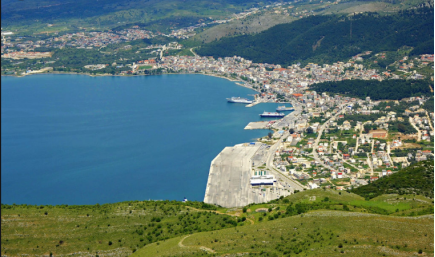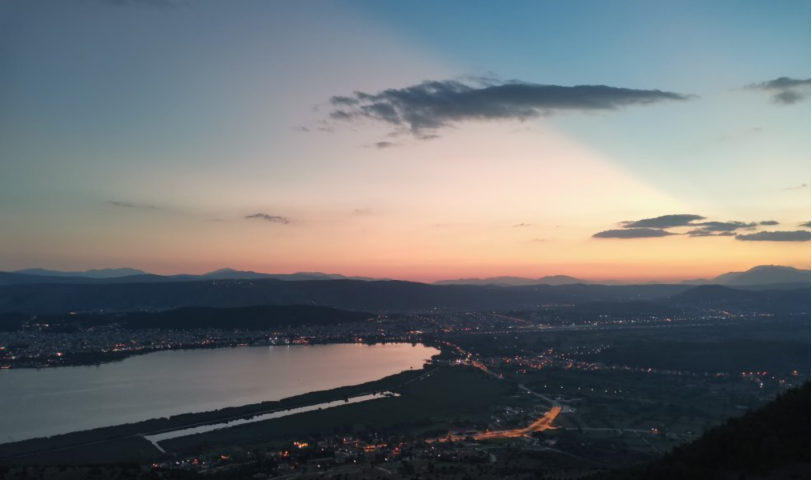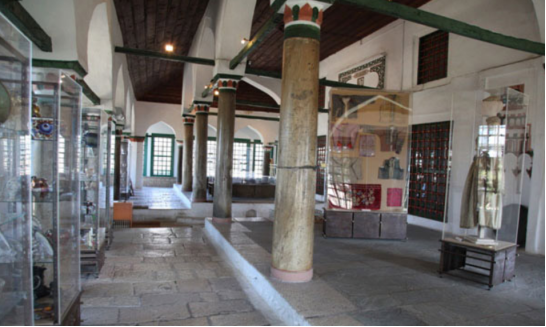Ioannina / Yannena , Lasithi, Crete 作者: 来源: 发布时间:2021-05-17
I. Population, Area
Total Area: 403.32 km2
Elevation: 480 m (1,570 ft)
Municipal unit density: 280/km2 (720/ sq mi)
Population: 112,486 (2011)

II.Natural Geography (environment and resources)
lSet on the western shore of the lovely Lake Pamvotis, Ioannina is one of northern Greece's most atmospheric cities, and one of its more cultured and wealthy, as it was famous throughout the Ottoman Empire for its silver artisans.
lThe walls of its old fortified city, the Kastro, enclose a tranquil quarter, spiked with minarets, and an island in the lake is a quiet, car-free escape. At sunset the lake turns silver and the impressive mountains behind turn lilac.
lIoannina is a beautiful place in every season, and worth at least a couple of days in a larger tour of Epiros; many Athenians visit as a romantic long weekend away.
lIoannina, often called Yannena within Greece, is the capital and largest city of the Ioannina regional unit and of Epirus, an administrative region in north-western Greece.
lThe city's foundation has traditionally been ascribed to the Byzantine Emperor Justinian in the 6th century AD, but modern archaeological research has uncovered evidence of Hellenistic settlements. Ioannina flourished in the late Byzantine period (13th–15th centuries).
Ioannina is served by Ioannina National Airport.
The Egnatia Odos highway, part of the E90, passes by Ioannina. It links the west coast port of Igoumenitsa with the borders.
Air Sea Lines flew from Lake Pamvotis to Corfu with seaplanes.
Air Sea Lines has suspended flights from Corfu to Ioannina since 2007. Long-distance buses (KTEL) travel daily to Athens (6–6.5 hours) and Thessaloniki (3 hours).
III. ECONOMY
Ioannina is famous throughout Greece for its silverwork, with a plethora of shops selling silver jewelry, bronzeware and decorative items (serving trays, recreations of shields and swords, etc.)
IV. Industrial Characterisitics
lDODONI S.A
Agricultural Dairy Industry of Epirus S.A. DODONI was established in 1963 by the Agricultural Bank of Greece and 6 Unions of Agricultural Cooperatives of the Epirus region. Today, DODONI is the leading Greek producer and exporter of cheese products. In 2010 the turnover came to 103,8 million € and net profits reached 7,8 million.
DODONI is the leading manufacturer of authentic FETA (P.D.O.), which is produced exclusively from fresh pasteurized ewe’s and goat’s milk, with a production capacity of about 15.000 tons annually in a tailor made, completely automated production line. Exported to 30 countries, DODONI Feta is the most branded Greek cheese, synonymous to superior and standard quality and authenticity all over the world.
Locations:
TAGMATARXI KOSTAKI 1 - ELEOYSA
IOANNINA, ΗΠΕΙΡΟΣ 45110, GR
V.Attractions
1.Lake Pamvotis

Lake Pamvotida or Pamvotis, commonly also Lake of Ioannina is the largest lake of Epirus, located in the central part of the Ioannina regional unit in northern Greece.
The regional capital Ioannina to the west and the town of Perama to the north are urban settlements fringing the lake while the remaining of its periphery is composed of farmland.
The lake features small fishing ports and a boating port. There is a regular boat service to the Ioannina Island. The Greek National Road 6 surrounds the northern half of the lake.
2.Municipal Ethnographic Museum

Municipal Ethnographic Museum Ioannina is located in the castle and is housed in the mosque of Aslan Pasha built in the early 17th century (probably in 1618) by Aslan Pasha, who ruled in Ioannina during the period 1600-1612.
Built on the site where according to tradition the Byzantine era, there was the church of St. John.
The Mosque of Aslan Pasha was the core of a large religious - educational complex, from which survives the homonym Tourbes (mausoleum), the Mendreses (seminary) and Mageireeia (outbreak).
The Municipal Museum houses three collections, representative of the castle residents during its long history: Christian, Jewish, Muslim. The objects are donations of prominent families, dating from the 18th to 20th century and utensils with utilitarian and decorative nature of various metals or porcelain. Also, one can see weapons and costumes typical of the Ottoman period.
The objects of the collection of Christians include ecclesiastical silverware, vestments and church books from the collection of Archbishop Spyridon. In the Jewish collection curtains from the building of the former synagogue, costumes and other items once thriving in the Jewish community of Ioannina are exposed. The objects from the Muslim population are exposed in the central area. There are oriental fabrics of the 16th, 17th and 18th, wood furniture and ivory of Ali Pasha era, bronze objects and Islamic books.
In the areas surrounding the mosque there is a powder keg, the cave of Dionysios the Philosopher, prominent Turkish tombs and a Medieval tower. Very close to this Citadel there are three important monuments of the Ottoman period. Those are The Bath, the Turkish library and Soufari seraglio.
VI. History
Ioannina can trace its roots back to the 6th c. AD, as an important town on the border of the Byzantine Empire. During that period the rocky promontory of Ioannina was enclosed by walls and the south-eastern hill (later known as Itch Kale) was inhabited. In 879 Ioannina is mentioned in written records for the first time as an Episcopal See. The area remained under Byzantine rule and only in 1082 did the Normans (Bohemund I) occupy the city for a few months. Following the Fourth Crusade (1204), Ioannina was incorporated in the Despotate of Epirus (Michael I Angelus Comnenus Ducas). In 1210 the Metropolitan Church of the Taxiarches was built (at Itch Kale). In 1292 the Philanthropinon School was founded on the Isle of lake Pamvotis - the lake which bathed the foot of the city walls -, rendering Ioannina an educational centre of great importance. The city rose in power and in 1318 the Ecumenical Patriarchate promoted it to a metropolis, whereas in 1367 it was granted self-governance.
The tower of Thomas Preljubovic in the castle (constructed from 1367 to 1384) highlights the monumental form that the city had acquired. Albanian tribes raided the city in 1379, but were forced to retreat. The gradual onward march of the Turks into the Balkans and the internal crisis of the Despotate of Epirus led to the subordination of Ioannina to the sphere of influence of Carlo I Tocco (Italian ruler of Cephalonia and Lefkada), who became a despot in 1411. However, on 9 October 1430 the city was voluntarily handed over to the Ottomans. The conquest lasted 483 years. Sinan Pasha granted the people of Ioannina privileges to settle and trade freely. However, the metropolitan church of the Taxiarches was converted to a mosque (Fethiye Tzami). At the same time, the construction of the namesake monastery in 1434 on the edge of Mount Mitsikeli and on the shores of lake by the Muslim Durahan reveals the spirit of conciliation and peaceful cohabitation between the Turks and the Greeks. However, this situation changed after the failed attempt of Dionysios Philosophos, the bishop who became the leader of discontented peasants and invaded Ioannina without however managing to deal a serious blow to the Turkish rulers. From then on the city's Christians were deprived of their privileges and were expelled from the castle, while 18 churches and monasteries were demolished. The Aslan Mosque was built in 1618 on the former location of the church of Agios Ioannis Prodromos (Saint John the Baptist), so that the mosques overlooked the area of the castle. Despite the blow that they had received, the inhabitants soon regained their financial and intellectual vitality. In 1648 the School of Epiphanios Igoumenos was founded, which was followed by the Gionma School (1672 - 1800), the Maroutsi School (1742 - 1749) and the Kaplaneios School (1805 - 1820).
Ioannina functioned as the centre for the ten schools that were founded in the wider area of Epirus. These schools were supported by emigrants from Ioannina and Epirus, who had settled mainly in Venice. From the mid-17th century, trade with the Adriatic ports was ever increasing, and the fact that the three eminent publishers of Greek books during the time of the Turkish occupation, namely Glykis (1670 - 1854), Saros (1681 - 1707) and Theodosiou (1755 - 1824), were from Epirus can be viewed as indicative of the region's general growth during that period. The majority of the teachers of the pre-revolutionary period taught n Ioannina: Georgios Sougdouris, Vissarion Makris, Parthenios Katzioulis, Mihail Mitrou in the 17th c., Balanos Vasilopoulos, Konstantinos Vasilopoulos, Evgenios Voulgaris, Methodios Anthrakitis in the 18th c., and Athanasios Psallidas, Ioannis Vilaras, etc. in the 19th c. The 18th century was an auspicious time for the city and the progress that was achieved was exploited by Ali Pasha, when he took over the governance in 1788. His economic and military power rendered the city a crossroad in the Balkans and foreign travellers marvelled at the court of Ali Pasha. However, he himself led the city to absolute destruction, since only one residence (today known as the "Despot's manor house") survived the fire of 25 August 1820. However, the final formation of the city walls (1815), as well as the arrangement of the settlement within the walls, is attributed to him.
Many legends originate from Ali Pasha's personality, yet the drowning of Kyra Frosini and the hanging of Katsandonis (1809) are real events. Following this period, the people of Ioannina regained strength and in 1828 the first Zosimaia Teachers School was founded, in 1833 the Metropolitan Church of Agios Athanasios opened and in 1867 the Seminary opened on the Isle. The hanging of Georgios the Neomartyr (1838) did not eliminate the harmony between the Muslims and the Christians. The Turks of Ioannina accepted Hellenic culture, in the same way the local Jewish element (whose presence in the region dates back to the early Byzantine period) was firmly bound to the area. In 1870 the seraglios of Itch Kale and part of the city, which as of then started to take on a different form due to the stone buildings, burned down. On 21 February 1913 the Greek army entered the city.
In the early 20th century the region was in turmoil twice; in 1917 with the Italian occupation and in 1944 (25th of March) when the Germans sent 1850 Jews to Auschwitz. After the Ottoman era came to an end, the city's intellectual life developed rapidly. The Teacher Training College, which later developed into the Zosimaia Academy, was founded (1913), whereas at the same time a Kindergarten Teacher Training College and later an Assistant Engineering School opened. Even before the liberation from Ottoman rule newspapers were printed, whereas during the interwar period, various types of magazines were published, of which the Epirotika Chronicles continue to survive till today. The post-war period witnessed an increase in the number of intellectual societies, the greatest one being the Society for Epirot Studies, which introduced the idea of a Folklore Museum and created a specialised Epirot library. Today, Ioannina is called on to play a dominant role in the Adriatic-Egnatia Odos axis, since, in terms of population (110,000 inhabitants of the basin), it constitutes the metropolis of Epirus as well as the economic and intellectual centre of northwestern Greece.
VII.Contact Information
Mayor: Professor M. Elisaf
Tel. contact: 2651361105
email : mayor@ioannina. gr
Address of the Citizen Service Centre
KEP 0322 Municipal Unit of Ioannina Address: El. Venizelos 4,
Ioannina TK 45445 Tel: 2651 0 36668, 2651 0 30645
Fax: 26510 70916, 2651 0 70173 e-mail: n.ioanninon@kep.gov.gr
JEP 0412 Municipal Unit of The East
Contact: 2651 0 85800, 2651 0 85801, 2651
3 61001 Fax: 2651 085802 e-mail: d.anatolis@kep.gov.gr
KEP 0240 Municipal Unit Pamvotidos
Tel. Contact: 2651 0 92279, 2651 3
61836 Fax: 2651 0 94721
e-mail: d.pamvotidos@kep.gov.gr
JEP 0725 Municipal Unit of Bizano tel:
2651 3 61724, 2651 3 61732
Fax:
2651 0 94025 e-mail: d.bizaniou@kep.gov.gr
JEP 0726 Municipal Unit of
Perama Tel. 2651 3 60731, 26513 60729 Fax: 2651 3 60730
e-mail: d.peramatos-ioanninon@kep.gov.gr
